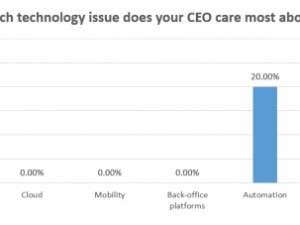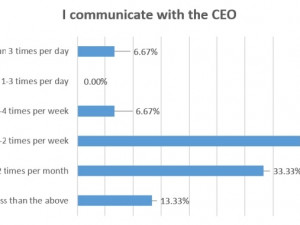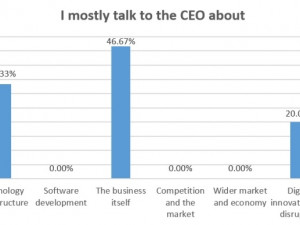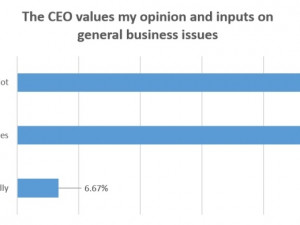What does the CEO expect from technology and the CIO? "I can tell you in one word," is Zoaib Hoosen's response to the question under investigation at the latest meeting of the CIO Council. And Microsoft South Africa's MD single-word answer? Simply, 'more'.
"The CEO expects more from the CIO. The CIO has their day job, but now more responsibilities are being added to that," he says.

Citing the recent geopolitical shifts, how digital technology is impacting how we live, work and play, and the rise of the age of the customer as just a few factors, Hoosen believes the CIO needs to be attuned to customer needs, the business strategy, and digital transformation, or risk being left behind.
But, he says, the CIO is not the only one facing that reality. "The context of the changing world isn't the preserve of the CIO; it impacts every one of us, regardless of where you sit in the organisation and what skills you have that you can contribute."
Hoosen says the CIO does have a unique set of skills that lend themselves to progressing in this digitally advancing world. Currently, however, the people driving the digital agenda come from the business itself as they want to move and innovate faster. "Innovation is almost happening outside of IT and IT is expected to enable it and make it happen. What is the opportunity cost of the CIO and CEO not partnering on this journey? The CIO needs to be bold and courageous and force their way to the boardroom table to bring their skills to the fore of digital transformation."

Tarsus Technology Group's CEO, Miles Crisp, agrees that the CIO needs to step up against the changing IT backdrop. "The CIO role takes on a whole new hue. You have to be the imagination factory in the business. Look at the technology innovation and disruption that's happening across the world and be in the face of the CEO and CFO, and make them aware of what's coming," he says.
Moving to the edges
Crisp also notes the changing nature of the digital world means organisations need to evolve from a centralised decision-making model. "This history of controlling everything stems from a lack of trust. With the way IT is moving today, this assumes you can trust people. IT has constantly got to put decision-making points closer to employees, the customer and the supplier. You cannot centralise decision-making."
Another tip he provides is to go beyond implementing functional technology, but ensure it's usable and fits the culture and organisation. "Systems have to be customer-friendly and user-friendly. You have to automate systems when you can, but don't lose the human touch from them. Real CIO value comes in understanding the dynamics of your organisation, not just the systems and processes."
The culture and interpersonal dynamics within the organisation are an area of concern for the CEO, says Crisp. With many different personalities and egos in an organisation, employees often compete against each other instead of collaborating. Where you find low levels of self-awareness, this often results in failure by employees to understand that they need each other to compensate for their own weaknesses. "How do I [as CEO] get the organisation to start firing on all cylinders? The answer is by raising self-awareness among employees and harness all the different thinking styles, talents and diversity. I need employees to start collaborating and partnering with colleagues that possess opposite skills to themselves. If you can get the team right and they have the imagination and flexibility to adapt, the issues of regulation, security, skills shortage and other macro factors become just the rules of the game (ie, you learn to play by them)."

Hollard Personal Line's MD Willem Smith believes mindsets need to change as technology and the world evolve around us. Smith talks about the changing medical technology field where algorithms already have a higher success rate than human doctors for diagnosing some ailments. Going forward, nanotechnology and personalised medicines, among other factors, will result in longer life spans. This will fundamentally change the personal insurance market, he says, but new and different opportunities will arise.
Insurance in a driverless world
The field of driverless cars, which are almost a reality, will fundamentally disrupt the personal insurance industry. "Around the globe, two-thirds of all car sales will disappear. You won't need to own a car in the future; as with Uber, you'll simply summon a driverless car, it will drop you off and pick up the next person.
"As a business leader, how do I respond to the disruption? It's difficult to predict exactly what will happen in the future and how. We need to stop being an insurance company and start being a technology company. We need to understand how insurers can use technology for their own benefit, otherwise we'll no longer be relevant. We need to embrace technology and execute on it faster than competitors. The existing platforms are old and cumbersome, and most organisations have a multitude of systems that aren't linked. Then there's the data - the 'holy grail' - if you can't link and use the data, it's meaningless. The organisation that gets this right, and the CIO that enables it, will win."

When it comes to the perspective of the CEO or MD about technology experimentation and roll-out, Smith says: "Mistakes aren't a problem, learn and fail fast. It's better to be there first and tweak later than not be there at all. That said, I would recommend you only dabble and play with 'bleeding edge' technology, don't bet the farm on it; rather stick with 'leading edge' technology."
Rochelle Josiah, chairman of the Talis Group, says it's vital not to forget the customer and change too fast. "Never alienate the end-user from the process of change. People change slowly, whereas technology changes fast. Change management is critical as new technology adoption can be stressful to customers and businesses alike.
"Undoubtedly, technology drives business growth," she says, "but it's the customer that keeps us in check. Good customer experience is repeat business. And, customers are not afraid to complain on social media if they're not happy.
"Start with the customer experience and work back towards the technology. Ultimately, a business without customers is not a business at all," concludes Josiah.
Mini-survey
During the CIO Council meeting, we polled a section of the audience with a mini-survey. From a room of approximately 90 delegates, we garnered 15 responses. The key findings are below. Perhaps the most significant finding is around how frequently (or infrequently) the respondent CIOs communicate with their CEOs.
Share
